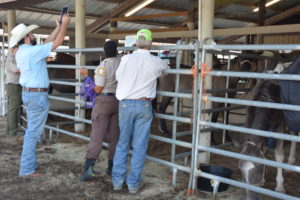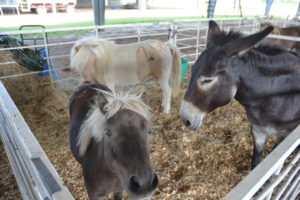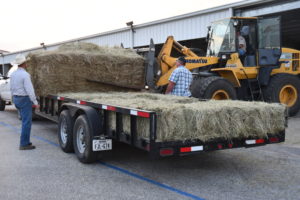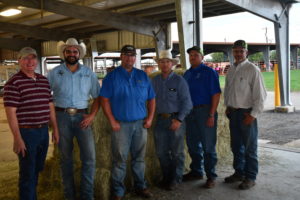Hearts of humans far-reaching as animal shelters fill with evacuees
Writer: Kathleen Phillips, 979-845-2872, ka-phillips@tamu.edu
Contact: Dr. Monty Dozier, 979-845-6800, monty.dozier@ag.tamu.edu
ANGLETON — Donations of time and supplies have come in all types and sizes to the animal shelter and supply point at the fairgrounds in Angleton, but all come with a common feature — caring, empathetic hearts of humans.
That is the sentiment expressed in many ways, both with and without words, as about 1,000 animals of all kinds are being cared for there since Hurricane Harvey unleashed its fury along the Texas coast Aug. 25.

“When we heard the hurricane was coming this way, we started making calls to prepare,” said Jessica Chase, Texas A&M AgriLife Extension Service agent for agriculture and natural resources in Brazoria County. “We don’t shelter in place here because it can be unsafe, depending on storm surge.”
Chase, who is managing the facility with alternating relief teams made up of her fellow AgriLife Extension agents from around Texas, is hosting evacuated and rescued horses, cattle, pigs, sheep, goats and a variety of birds. Dogs and cats at the site are managed in cooperation with the local Society for the Prevention of Cruelty to Animals.
The shelter began taking animals on Aug. 25 from people in areas most likely to flood, Chase said.

“On Saturday (Aug. 26), it went through the roof with the number of animals we were getting in,” Chase said. “The rain was blowing in, but we kept taking the animals. We started calling for people to help go out and get animals to bring here if their owners weren’t able. Our volunteers would drop them off, then go out and get more.”

Chase said the facility established an ownership system so each animal is photographed with the owner and numbered to help with when they are “discharged” once the flood waters recede.
One of the biggest issues initially was how to manage space. The fairgrounds are equipped with a variety of covered buildings intended for animals but not with individual stalls. The team of AgriLife Extension personnel and a variety of local people and businesses were able to loan the facility panels, or specialized livestock fencing, to quickly piece together makeshift areas for each animal. The area was further organized by species in different arenas, Chase said.

With more than 1,000 animals housed by owners who evacuated, the team then began receiving word of additional animals that were abandoned or in need of being rescued. Teams of rescuers along with various state and federal agencies continue to assist with rescues, some of which are in areas where animals have been standing in flood waters since the storm.

The animal shelter provided a welcome site from the hurricane’s aftermath for John Barksdale. When forced to evacuate his home in Brazoria as nearby rivers were anticipated to crest at historic levels and cause even more extensive flooding, Barksdale moved his camper to the fairgrounds even though he had no animals in need of shelter. Barksdale remained and provided volunteer assistance.
“What I’ve been doing is watering the horses twice a day, so that they’re going to be OK,” Barksdale said. “I couldn’t just sit around and watch people doing things for other people. I said ‘let’s go to work,’ so here I am.”
That was the same notion expressed by Choco Galvez, who gathered up friend Garrett Collenback, both of San Antonio, to help drive about 800 pounds of animal feed and various other animal needs to supply points in the hardest-hit areas.
“I love to help people, so it was an easy transfer for me to also help animals,” Galvez said, after helping volunteers at the Angleton facility unload supplies from his trailer and pickup. “I just got tired of seeing so many people and animals suffering. And I said, ‘I have to do something.’
“I’m one guy with a truck. I knew Garrett would help me, so there’s two people,” he added. “If you really want to help people and animals, get off your butt and go do something.”

Managing 1,000 critters requires at least as many people given that each owner is caring for their own and volunteers are tending to strays, and Chase credited the local community as well as her AgriLife Extension colleagues for making it work.
Dr. Monty Dozier, AgriLife Extension regional program leader in College Station, was one of the first to show up. Dozier said the agency has trained its personnel representing all 254 Texas counties to know how to respond to disasters in order to assist their co-workers who may be overwhelmed when disaster strikes on their own turf.
“We set up district partners of agents across the state that are on agriculture ‘strike teams’ to come in and seamlessly take over the operation, run it for about five days and then another strike team comes in,” Dozier said. “That way, we keep our local agents fresh, and they can deal with more local issues if they need to.”
In Angleton, the strike teams were helping with a two-pronged operation, he said.

“We’re sheltering animals that have been evacuated from flood-prone areas,” Dozier said, “and we are now accepting donations of feed and other supplies to help take care of these animals and assist owners who may have lost all their feed in the floods.”
AgriLife Extension continues to assist with various animal shelters in the area. To find out what supplies are needed or how to volunteer, call 979-845-7800.


